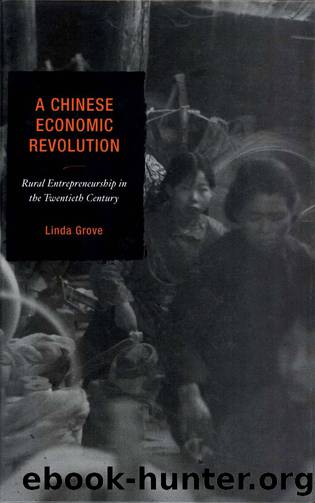A Chinese Economic Revolution by Grove Linda;

Author:Grove, Linda;
Language: eng
Format: epub
ISBN: 9780742573260
Publisher: Rowman & Littlefield Publishers
Published: 2016-03-29T00:00:00+00:00
6
Wartime Collapse
From the beginning of its rise as an industrial district, Gaoyang industry was enmeshed in a web of finely intertwined relationships that linked rural producers to suppliers, markets, and financial institutions outside the local community. Modern textile mills supplied the yarn, finished goods were marketed in a nationwide market, and accounts were settled through Tianjin native banks. The Japanese invasion in the summer of 1937 ripped apart this web of relationships and brought production in the industrial district to a sudden halt. Although it would not have been immediately obvious to contemporary observers, in hindsight we can see that the war also marked the end of Gaoyang industry under the direction of the relatively large firms whose growth we have followed in the earlier chapters. When industry entered a second phase of growth, after the Japanese surrender in 1945, a system based partly on socialist prototypes and partly on small-scale, locally generated workshop capital would play a central role. In this chapter we will look at the collapse of the industrial district as a result of the Japanese invasion, the wartime attempts to revive production, and what those processes reveal about the internal dynamics of the Gaoyang system of production.
The Japanese armed invasion of China was triggered by the well-known clash at the Marco Polo Bridge outside Beijing in July 1937, and the first brunt of the Japanese attack fell on the central Hebei plains. The plains region became one of the focal points of struggles between the Japanese occupying armies and the Chinese Communist Party-organized resistance. The first of the wartime anti-Japanese base areas, the Shanxi-Chahar-Hebei anti-Japanese base area (Jin-Cha-Ji), was created in this area in 1938; Gaoyang was in the center of the central Hebei base, which was a subregion of the Jin-Cha-Ji anti-Japanese base area. The first headquarters of the central Hebei anti-Japanese resistance was set up in Gaoyang and throughout the war years the former weaving areas were part of the core of the resistance zone.
The war was bitterly fought, as Japanese forces struggled to gain political and economic control over the strategic plains, and losses were heavy on both sides. By the early 1940s Gaoyang was garrisoned by regular Japanese forces and their Chinese puppet allies who had built six strong points in the county and had troops in fortified watchtowers in more than twenty villages.1 More than twenty-five hundred people in Gaoyang lost their lives as a result of active participation in the wartime resistance struggles; this number does not include those who were victims, but not active members of the resistance.2 Although this chapter will touch only tangentially on the political and social issues related to the resistance struggle, it is important to keep them in mind as the background to the other changes that took place.3
As Japanese armies began their swift advance south from Beijing and Tianjin in the summer of 1937, moving down the major rail lines that cut across the North China Plain, local governments dissolved. Magistrates, local government officials, and members of the local police forces retreated before the advancing armies.
Download
This site does not store any files on its server. We only index and link to content provided by other sites. Please contact the content providers to delete copyright contents if any and email us, we'll remove relevant links or contents immediately.
| Central Asia | Southeast Asia |
| China | Hong Kong |
| India | Japan |
| Korea | Pakistan |
| Philippines | Russia |
The Rape of Nanking by Iris Chang(3518)
The Sympathizer by Viet Thanh Nguyen(3487)
World without end by Ken Follett(3008)
Ants Among Elephants by Sujatha Gidla(2925)
Blood and Sand by Alex Von Tunzelmann(2610)
Japanese Design by Patricia J. Graham(2558)
City of Djinns: a year in Delhi by William Dalrymple(2137)
Inglorious Empire by Shashi Tharoor(2102)
Foreign Devils on the Silk Road: The Search for the Lost Treasures of Central Asia by Peter Hopkirk(2056)
In Order to Live: A North Korean Girl's Journey to Freedom by Yeonmi Park(2055)
Tokyo by Rob Goss(2018)
India's Ancient Past by R.S. Sharma(1988)
India's biggest cover-up by Dhar Anuj(1986)
The Great Game: On Secret Service in High Asia by Peter Hopkirk(1962)
Tokyo Geek's Guide: Manga, Anime, Gaming, Cosplay, Toys, Idols & More - The Ultimate Guide to Japan's Otaku Culture by Simone Gianni(1947)
Goodbye Madame Butterfly(1937)
The Queen of Nothing by Holly Black(1757)
Living Silence in Burma by Christina Fink(1731)
Batik by Rudolf Smend(1722)
